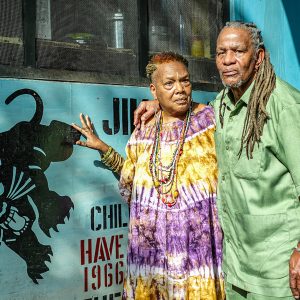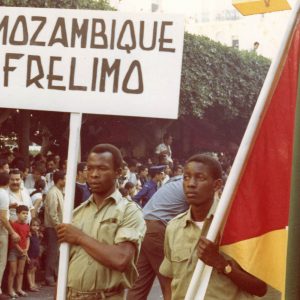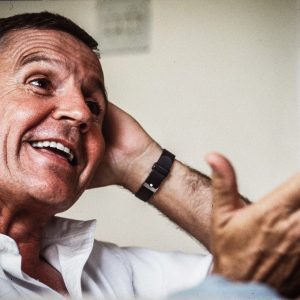Film and the radical politics of the long 1960s
In an era of decolonisation, feminism, gay liberation and pop counterculture, movies not only responded to the rebellious ideas of the moment but also helped shape them.
Author:
6 May 2021

The gripping political thriller Judas and the Black Messiah focuses on the assassination of Black Panther Party leader Fred Hampton, played by British actor Daniel Kaluuya, who won the 2021 Best Supporting Actor Oscar for the role.
Director Shaka King shows how the Federal Bureau of Investigation (FBI) used informant William O’Neal (played by LaKeith Stanfield) to infiltrate Hampton’s inner circle and set him up to be murdered by the Chicago police in 1969.
The United States government was engaged in a covert war with both the Black Power movement and the wider Left, which was against the Vietnam War, in the late 1960s. The brutal war in Asia – during which more bombs were dropped than by all sides in World War II – led to intense moral revulsion, domestically and abroad.
Despotic FBI head J Edgar Hoover (played by Martin Sheen) – a man so powerful that even American presidents were afraid of him – wanted to “prevent the rise of a ‘messiah’ who could unify and electrify the militant Black nationalist movement”.
Hoover and other reactionaries demonised the Black Panthers as unhinged militants. But in reality, the Panther’s primary support came from their grassroots initiatives, such as free breakfast for impoverished schoolchildren.
Related article:
Activists like Hampton strived to create cross-racial, socialist and democratic alliances to connect Black revolutionaries with Latino, Asian and white dissidents. As the film suggests, Hampton offered what Noam Chomsky once called “the threat of a good example”, leading to the state murdering him.
To destroy this cultural insurgency, the FBI established its counterintelligence programme, while the Central Intelligence Agency (CIA) created its domestic espionage project Operation Chaos. Using illegal methods such as wiretapping and framing activists on drug charges, it also exploited tensions between radical groups by spreading misinformation and planting agent provocateurs who encouraged criminal and rash actions.
One of the targets was the actress Jean Seberg, who publicly supported the Black Power movement. She was best known for her role in Jean Luc-Godard’s Breathless (1960), a film that exemplified the French New Wave, a radical style of movie making that had a profound influence on global cinema in the 1960s. Under the pressure of a vicious smear campaign, which included leaking fabricated stories about her to the press, she died by suicide in 1979.
Global struggles
The brutality with which the US state responded to the social movements of the 1960s was part of a global wave of repression. As historian George Katsiaficas writes in The Global Imagination of 1968, almost every country in the world saw social and political upheaval.
Student demonstrators in Europe, Asia and America protested against imperialism and the military-industrial complex, while their counterparts in Eastern Europe challenged crooked Stalanist bureaucracies.
Decolonisation struggles, feminism, gay liberation, the counterculture of pop music and experimentation with “mind expansion” formed a swirl of what Andrew Nette and Iain McIntyre call “radical and rebellious ideas and practices [challenging] everyday life and existing prejudices”. Many of these social changes continued to unfold well into the mid-1970s, which is why this period is often called “the long 1960s”.
The spread of films, television and cheap mass-market paperbacks allowed for a global idiom of struggle. The Black Panthers, for instance, inspired an Aboriginal Panther group in Australia and Dalit Panthers in India. It also led to the antiracist White Panther Party of Detroit, today best known for its call for “a total assault on the culture by any means necessary, including rock ’n’ roll, dope and fucking in the streets”.
Clouds of tear gas
Such a heady political climate was sure to invade the film industry – sometimes quite literally, as when the 1968 Cannes Festival was cancelled in the midst of a student and worker uprising that rocked France.
Unable to ignore the cloud of police tear gas spreading around the world, Hollywood capitalised on the youth insurgency with films such as the oddity Wild in the Streets (1968), in which hippies seize control of the US political system and force everyone over 35 into re-education camps where they are dosed with LSD.
But film not only responded to these wild years, it also helped shape them.
A former antiwar activist recalled how radicals in the US helped revive the Italian-Algerian guerilla war film The Battle of Algiers (1966). “You saw [it] 10 times so you could memorise how to build the proper cell structure. I’ll never forget seeing a platoon of Black Panthers, in matching black leather jackets and berets, sitting in front of me, taking notes during the show.”
Related article:
In turn, young Hollywood filmmakers and stars who shared countercultural sympathies produced work that spoke directly to an alienated and rebellious youth. Bonnie and Clyde (1968) depicted Faye Dunaway and Warren Beatty as glamorous outlaws, with Dunaway wearing a Che Guevara-style beret while robbing banks and shooting it out with the law.
The surprise smash hit Easy Rider (1969) focused on two nonconformist bikers on an epic road trip through the US. The characters represent different aspects of the youth counterculture. Peter Fonda is idealistic and self-questioning while Dennis Hopper is hedonistic and bug-eyed with drug-fuelled paranoia. The film reflected fears that the utopian hopes of the 1960s were turning into something darker, as in Fonda’s famously ambivalent line, “We blew it.”
Both these films end with authority figures killing the protagonists. This reflected the intense political violence of the era. The police massacred hundreds of young protesters in Mexico in October 1968. At Kent State in Ohio two years later, the National Guard killed four students who were protesting against the escalated bombing of Cambodia.
Former US president Richard Nixon, a hardline right-winger who was so paranoid that he kept an “enemies list” (which included actors Paul Newman and Jane Fonda), exemplified this reactive turn. Bizarrely, after the Kent State massacre, a drunk Nixon went to speak to antiwar protesters at the Lincoln Memorial, a surreal incident dramatised in Oliver Stone’s Nixon (1995).
Radical filmmakers imagined a future of endless repression and revolt. In the dystopian Punishment Park (1971), Nixon’s jails are so full of antiwar protesters that they are let out and then hunted for sport.
Related article:
In The Spook Who Sat by the Door (1973), a disillusioned Black CIA agent uses his skills to train militants to overthrow the government. Director Sam Greenlee’s film was so incendiary that the FBI allegedly pushed to have the film suppressed from release. It was pulled from cinemas almost as soon as it came out.
In turn, conservative films presented hippies and radicals as a new kind of villain. In the vigilante cop film Dirty Harry (1971), loose cannon cop Clint Eastwood hunts down a sadistic serial killer whose belt buckle conspicuously takes the form of a peace sign, originally an antiwar symbol.
The ruthless, punitive justice of Dirty Harry reflected a new “law and order” politics that would culminate in the conservative political victories of Margaret Thatcher and Ronald Reagan at the end of the decade. These politicians promised to roll back the dissidence and rebellion of the long 1960s, and restore “traditional values” and respect for authority.
Death trip
In fact, state repression convinced some leftists that armed confrontation was the only route to social justice. It is often forgotten today, but underground revolutionaries regularly committed sabotage throughout the world in the 1970s. There were 3 000 political bombings in the US in one month alone in 1970.
Many of these actions were aimed at infrastructure linked to the Vietnam War and not people. But more hardline groups such as the Weather Underground in the US and the West German Red Army Faction (better known as the Baader-Meinhof Gang) saw themselves as the vanguard of a people’s war. They believed that provoking the state into greater repression against the Left would precipitate a revolution. As in Bonnie and Clyde, violence for them was a radical act.
This was a fatal miscalculation, as these groups often found themselves hunted by the state and distrusted by other leftists. As recorded in a 2002 documentary, Hampton himself denounced the Weathermen as “opportunistic”, “chauvinistic” and focused on seeking violent glory rather than doing the work of building community and creating lasting social change.
Related article:
In an even more extreme case, the Japanese United Red Army committed an internal purge when it executed 14 of its own members. The subsequent manhunt and standoff with the police was a huge blow for the antiwar and student movement in Japan. The 2007 United Red Army by Japanese director Kōji Wakamatsu is a disturbing, yet epic, reconstruction of these sinister events.
The story of the United Red Army exposes the dark side of the 1960s. Revolutionary enthusiasm in some cases led to militarism and cultish fanaticism, while the focus on using sexuality and drugs to achieve self-liberation could curdle into decadence and nihilism.
As historian James Riley has said, underneath the bright hopes of peace and love was a fascination with the apocalypse and destruction. This sense of dread was captured in movies such as Performance (1970), a British psychedelic crime movie that shows the euphoria of the 1960s turning strange and menacing. Performance’s audacious depiction of cultural decadence so freaked out Warner Brothers that the studio refused to release it for two years.
Related article:
Charles Manson, the career criminal turned aspirant pop singer and cult leader, exemplified the late 1960’s death trip. After failing to establish a career in Hollywood, Manson lead his hippie murder squad into a series of brutal killings, whose vicims included film actress Sharon Tate and celebrity hair stylist Jay Sebring. These events continue to be restaged and reimagined in film and television, most recently in Quentin Tarantino’s Once Upon a Time in Hollywood (2019).
Fuelled by apocalyptic beliefs about an upcoming race war and industrial quantities of LSD, the Manson “family” offered a grotesque perversion of the hopes of the counterculture. (A hardened bigot, Manson believed the murders would be blamed on Black militants). Despite this, Weather Underground leader Bernadine Dohrn proclaimed the murders were “far out! The Weatherman digs Charles Manson.”
A few months after these murders, more violence occurred at a Rolling Stones concert at the Altamont race track in California. In front of a crowd high on dangerously low-quality LSD and methamphetamine, the Hell’s Angels motorcycle gang (who had naively been hired to provide security) murdered a member of the audience while singer Mick Jagger attempted to calm the crowd. This was captured in terrifying detail in the documentary Gimme Shelter (1970).
Lasting legacy
But as film historian Karina Longworth has said, the cultural trauma of Vietnam and the Manson murders inspired a new sophistication and realism in Hollywood film.
So-called “new Hollywood” directors such as Francis Ford Coppola, Martin Scorsese and William Friedkin ushered in a wave of powerful dramas and neo-noir thrillers in the 1970s. They reflected the turmoil of the late 1960s and offered commentary on capitalism, patriarchy and organised religion in films such as The Godfather (1972) and The Godfather Part II (1974), The Conversation (1974), The Exorcist (1973), Mean Streets (1973) and Taxi Driver (1976).
The iconic male lead of the decade was Al Pacino, who reflected the anti-authoritarianism and alienation of the counterculture in Serpico (1973) and Dog Day Afternoon (1975).
The 1970s is often seen as a golden age for ambitious film-making. This creative energy rode off the cultural forces unleashed during the radical 1960s – and as seen in the acclaim given to Judas and the Black Messiah, is still inspiring filmmakers.





